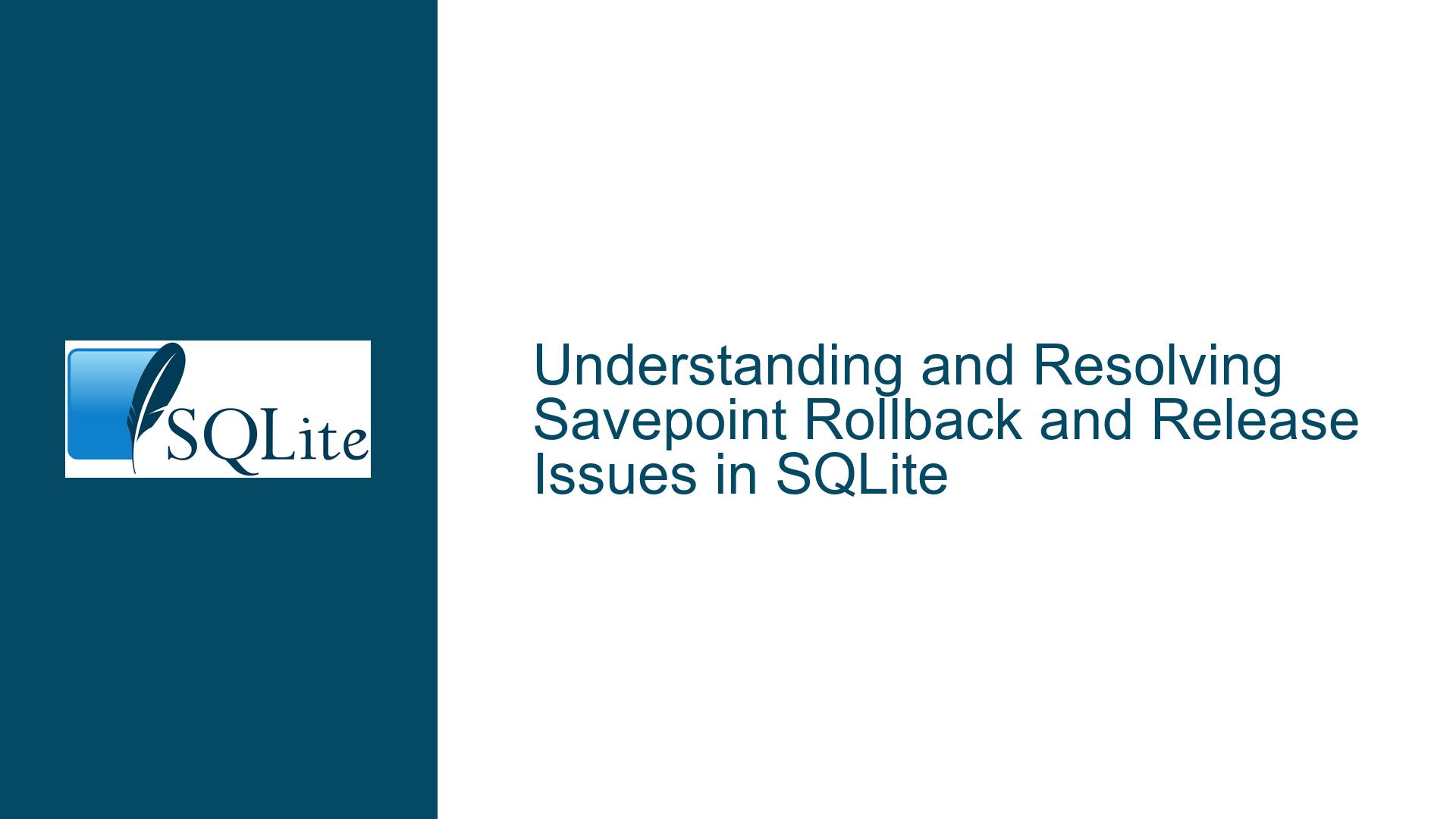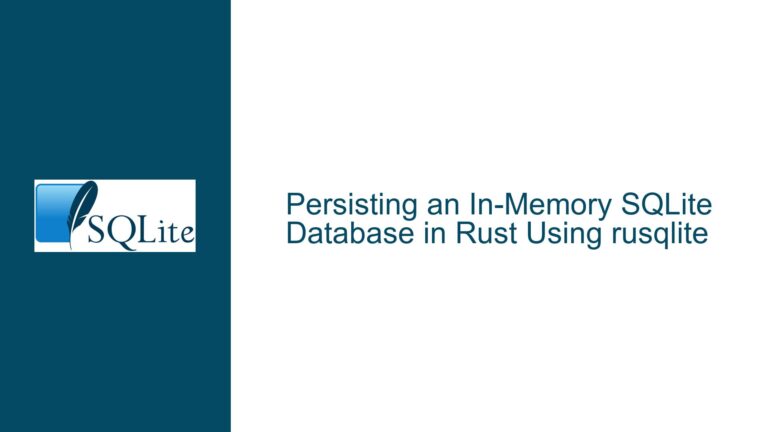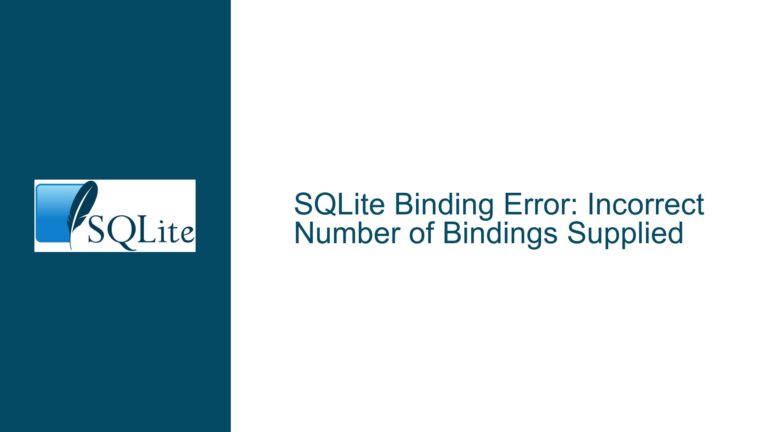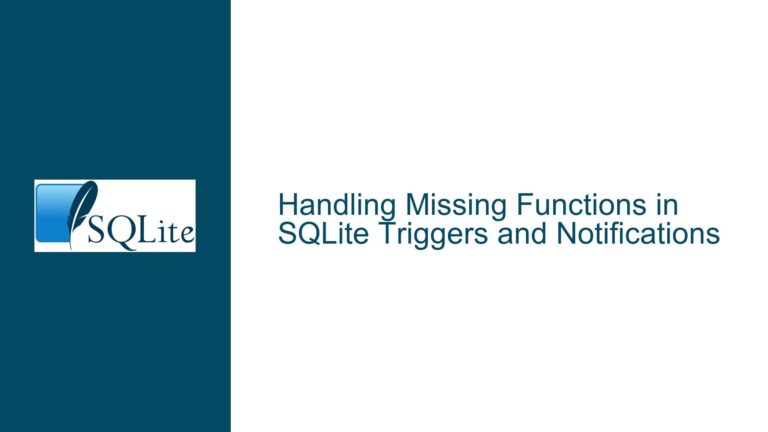and Resolving Savepoint Rollback and Release Issues in SQLite
Issue Overview: Misunderstanding Savepoint Rollback and Release Behavior
The core issue revolves around the behavior of SQLite’s ROLLBACK TO SAVEPOINT and RELEASE SAVEPOINT commands, particularly in scenarios where nested transactions or savepoints are used. The confusion arises from the expectation that rolling back to a savepoint would automatically release it, thereby cleaning up the transaction state. However, this is not the case in SQLite. When you execute ROLLBACK TO SAVEPOINT, the transaction is rolled back to the state at the time the savepoint was created, but the savepoint itself remains active. This means that the savepoint must be explicitly released using the RELEASE SAVEPOINT command to fully clean up the transaction state.
This behavior can lead to several issues, especially in complex transaction scenarios where multiple savepoints are created and rolled back. For instance, if a function creates a savepoint, performs some operations, and then rolls back to that savepoint, the savepoint remains active unless explicitly released. If the function is called within an existing transaction, this can result in an open transaction with no changes, which can cause unexpected behavior or performance issues. Additionally, if the function is called outside of an existing transaction, it may leave an open transaction with no changes, which can lead to similar issues.
The confusion is further compounded by the fact that the documentation clearly states that ROLLBACK TO SAVEPOINT does not release the savepoint, but this detail is often overlooked or misunderstood by developers. This can lead to scenarios where developers inadvertently build up a large number of savepoints within a transaction, which can degrade performance and lead to unexpected behavior.
Possible Causes: Misinterpretation of Savepoint Behavior and Transaction Management
The primary cause of the issue is a misinterpretation of how savepoints work in SQLite, particularly in relation to transaction management. Developers often assume that rolling back to a savepoint will automatically release it, thereby cleaning up the transaction state. However, this is not the case. The savepoint remains active after a rollback, and must be explicitly released using the RELEASE SAVEPOINT command.
This misunderstanding can lead to several issues, particularly in scenarios where nested transactions or savepoints are used. For example, if a function creates a savepoint, performs some operations, and then rolls back to that savepoint, the savepoint remains active unless explicitly released. If the function is called within an existing transaction, this can result in an open transaction with no changes, which can cause unexpected behavior or performance issues. Additionally, if the function is called outside of an existing transaction, it may leave an open transaction with no changes, which can lead to similar issues.
Another potential cause of the issue is the lack of awareness of the different types of transaction scenarios that can occur in SQLite. As mentioned in the discussion, there are typically three types of scenarios when using transactions:
- Simple Transaction: You start a transaction, it completes, and you commit it.
- Failed Transaction: You start a transaction, it fails at some point, and you roll it back.
- Checkpointed Transaction: You start a transaction, checkpoint as you go with the option to roll back to a previous point in order to redo the last section, and then commit or rollback all if need be.
The third scenario, which involves the use of savepoints, is only worth doing if the process of building the transaction is processing-intensive and takes a lot of time, or if you expect a high likelihood of failure in the transaction or specific sections thereof. However, if developers are not fully aware of how savepoints work, they may inadvertently create complex transaction scenarios that lead to the issues described above.
Troubleshooting Steps, Solutions & Fixes: Properly Managing Savepoints and Transactions
To resolve the issues related to savepoint rollback and release behavior in SQLite, it is important to properly manage savepoints and transactions. This involves understanding how savepoints work, and ensuring that they are explicitly released after a rollback. Below are some detailed steps and solutions to help troubleshoot and fix these issues:
Understand the Behavior of
ROLLBACK TO SAVEPOINTandRELEASE SAVEPOINT: The first step in resolving the issue is to fully understand howROLLBACK TO SAVEPOINTandRELEASE SAVEPOINTwork in SQLite. As mentioned earlier,ROLLBACK TO SAVEPOINTrolls back the transaction to the state at the time the savepoint was created, but does not release the savepoint. The savepoint must be explicitly released using theRELEASE SAVEPOINTcommand. This behavior is clearly documented, but it is important to ensure that developers are aware of it and understand its implications.Explicitly Release Savepoints After Rollback: To avoid leaving savepoints active after a rollback, it is important to explicitly release them using the
RELEASE SAVEPOINTcommand. This should be done in all cases, regardless of whether the rollback was successful or not. For example, if a function creates a savepoint, performs some operations, and then rolls back to that savepoint, the savepoint should be explicitly released before the function exits. This ensures that the transaction state is properly cleaned up, and prevents the accumulation of active savepoints within a transaction.Use Nested Transactions with Caution: Nested transactions can be useful in certain scenarios, but they can also lead to complex transaction management issues if not used carefully. When using nested transactions, it is important to ensure that each savepoint is properly managed, and that they are explicitly released after a rollback. Additionally, it is important to consider whether the use of nested transactions is necessary, and whether the benefits outweigh the potential complexity and risks.
Monitor and Manage Transaction State: In complex transaction scenarios, it is important to monitor and manage the transaction state to ensure that it is properly cleaned up. This can be done by keeping track of the savepoints that have been created, and ensuring that they are explicitly released after a rollback. Additionally, it is important to monitor the performance of the transaction, and to identify any potential issues that may arise from the accumulation of active savepoints.
Consider Alternative Transaction Management Strategies: In some cases, it may be more appropriate to use alternative transaction management strategies, rather than relying on nested transactions and savepoints. For example, if the process of building the transaction is processing-intensive and takes a lot of time, it may be more efficient to break the transaction into smaller, more manageable pieces, and to commit each piece separately. This can help to reduce the complexity of the transaction, and to avoid the potential issues associated with nested transactions and savepoints.
Review and Update Documentation: Finally, it is important to review and update the documentation to ensure that it clearly explains the behavior of
ROLLBACK TO SAVEPOINTandRELEASE SAVEPOINT, and provides guidance on how to properly manage savepoints and transactions. This can help to prevent misunderstandings and ensure that developers are aware of the potential issues and how to avoid them.
By following these steps and solutions, developers can effectively troubleshoot and resolve the issues related to savepoint rollback and release behavior in SQLite, and ensure that their transactions are properly managed and cleaned up. This will help to prevent unexpected behavior and performance issues, and ensure that the database operates efficiently and reliably.






